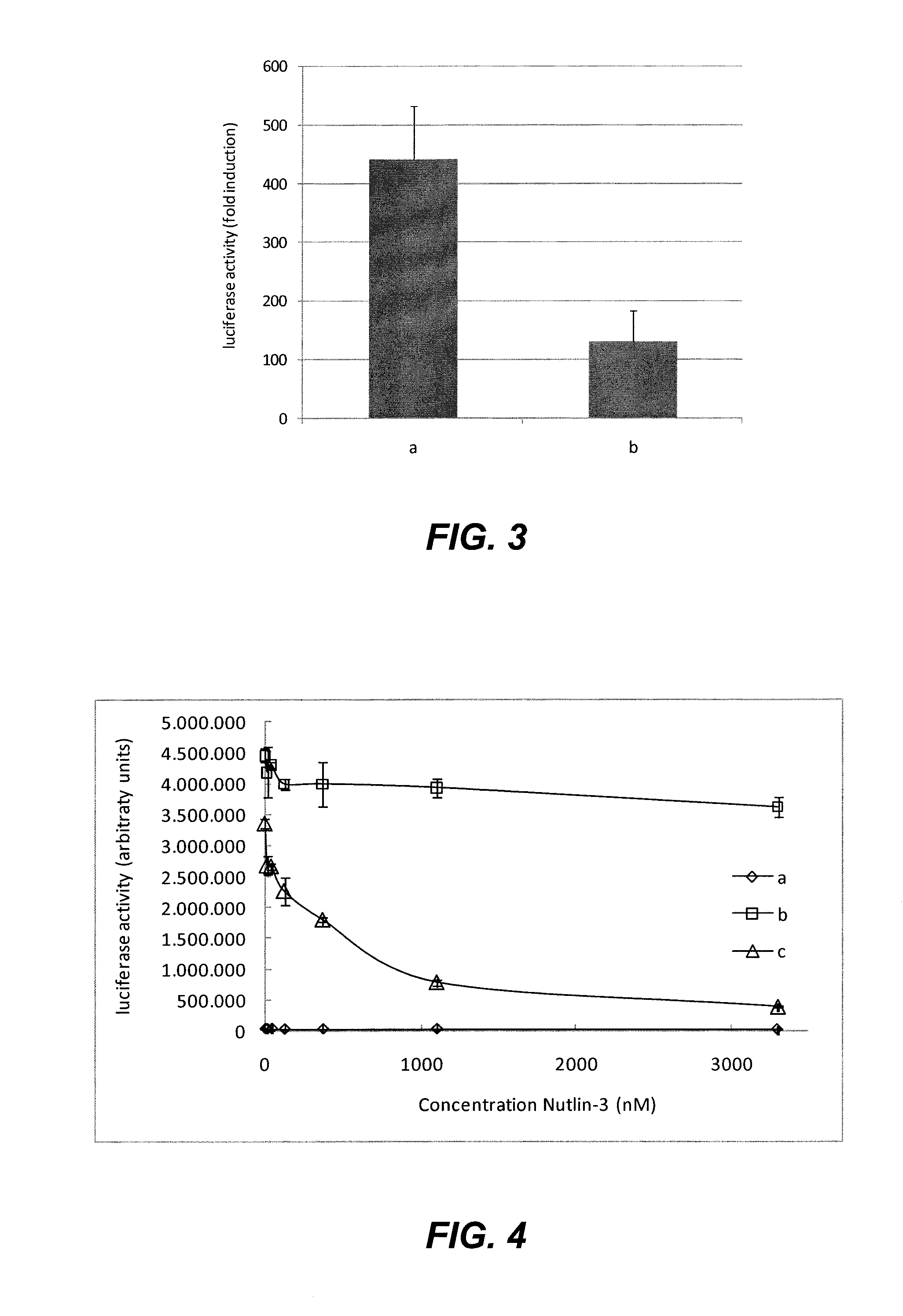Kinase substrate sensor
a substrate sensor and kinase technology, applied in the field of cytoplasmic protein complexes, can solve the problems of requiring lysis to corrupt the normal cellular context, requiring high throughput screening, and tedious methods
- Summary
- Abstract
- Description
- Claims
- Application Information
AI Technical Summary
Benefits of technology
Problems solved by technology
Method used
Image
Examples
example 1
Detection of the Interaction Between HIV1 Reverse Transcriptase (RT) Subunits
[0062]In order to determine the functionality of the assay, the interaction between HIV1 subunits that form homo- and heterodimers was tested by transfecting the following combinations of plasmids (100 ng of the Tyk2(C) fusion construct, 1 μg of the gp130 fusion construct and 50 ng of the luciferase reporter construct) according to the methods described above:[0063]a) pMet7-HA-Tyk2(C)-RTp66+pMG2-RTp51+pXP2d2-rPAPI-luciferase[0064]b) pMet7-HA-Tyk2(C)-RTp66+pMG2-RTp66+pXP2d2-rPAPI-luciferase[0065]c) pMet7-HA-Tyk2(C)-RTp51+pMG2-RTp51+pXP2d2-rPAPI-luciferase
[0066]Background signal for each Tyk2(C) fusion polypeptide was determined by transfecting the plasmid that encodes it together with a plasmid encoding an unfused gp130 fragment (pMG1) and the luciferase reporter plasmid (pMet7-HA-Tyk2(C)-RTp66+pMG1+pXP2d2-rPAPI-luciferase in a) and b); pMet7-HA-Tyk2(C)-RTp51+pMG1+pXP2d2-rPAPI-luciferase in c)). The fold ind...
example 2
Interaction Between Nuclear Proteins
[0067]To determine whether the method can detect interactions between nuclear proteins, we tested the interaction between HIV 1 Integrase (IN) and human LEDGF and between human p53 and MDM2, proteins with a nuclear localization. Cells were transfected with the following combinations of plasmids (250 ng of the Tyk2(C) fusion construct, 500 ng of the gp1 30 fusion construct and 50 ng of the luciferase reporter construct) according to the methods described above:[0068]a) pMet7-HA-Tyk2(C)-LEDGF+pMG2-IN+pXP2d2-rPAPI-luciferase[0069]b) pMet7-HA-Tyk2(C)-MDM2+pMG1-p53+pXP2d2-rPAPI-luciferase
[0070]Background signal for each Tyk2(C) fusion polypeptide was determined by transfecting the plasmid that encodes it together with a plasmid encoding an unfused gp130 fragment (pMG1) and the luciferase reporter plasmid (pMet7-HA-Tyk2(C)-LEDGF+pMG1+pXP2d2-rPAPI-luciferase in a); pMet7-HA-Tyk2(C)-MDM2+pMG1+pXP2d2-rPAPI-luciferase in b)). The fold induction for each tes...
example 3
Dose-Dependent Disruption of the Interaction Between Human p53 and MDM2 by Nutlin-3
[0071]To show that the method can detect modulation of protein-protein interactions by small molecules, we analyzed the interaction between p53 and MDM2, which has been reported to be disrupted by Nutlin-3, a member of the nutlin family of potential novel anti-cancer compounds (Vassilev et al., 2004). Cells were transfected with the following combinations of plasmids (100 ng of the Tyk2(C) fusion construct, 1000 ng of the gp130 fusion construct and 50 ng of the luciferase reporter construct) according to the methods described above:[0072]a) pMet7-HA-Tyk2(C)-p53(N)+pMG1+pXP2d2-rPAPI-luciferase[0073]b) pMet7-HA-Tyk2(C)-p53(N)+pMG1-EFHA1+pXP2d2-rPAPI-luciferase[0074]c) pMet7-HA-Tyk2(C)-p53(N)+pMG2-MDM2+pXP2 d2-rPAPI-luciferase
[0075]After transfection, cells were treated with 0-14-41-123-370-1111-3333 nM Nutlin-3, final concentration. The results shown in FIG. 4 show a dose-dependent decrease of the signa...
PUM
| Property | Measurement | Unit |
|---|---|---|
| Interaction | aaaaa | aaaaa |
Abstract
Description
Claims
Application Information
 Login to View More
Login to View More - R&D
- Intellectual Property
- Life Sciences
- Materials
- Tech Scout
- Unparalleled Data Quality
- Higher Quality Content
- 60% Fewer Hallucinations
Browse by: Latest US Patents, China's latest patents, Technical Efficacy Thesaurus, Application Domain, Technology Topic, Popular Technical Reports.
© 2025 PatSnap. All rights reserved.Legal|Privacy policy|Modern Slavery Act Transparency Statement|Sitemap|About US| Contact US: help@patsnap.com



